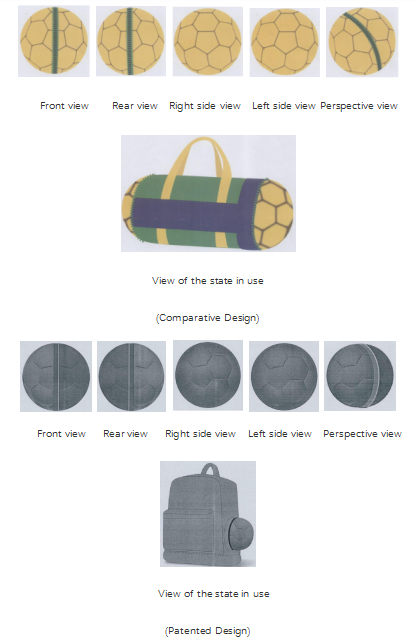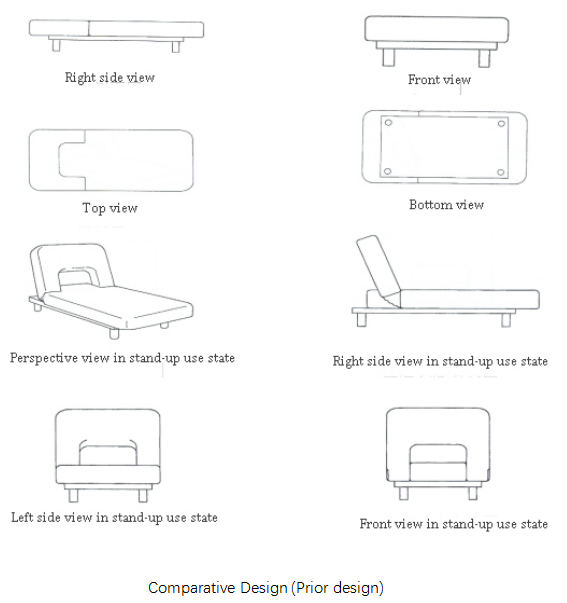According to Article 64 of the Chinese Patent Law, the extent of protection of the patent right for design shall be determined by the design of the product as shown in the drawings or photographs, and the brief explanation may be used to interpret the design of the product as shown in the drawings or photographs.. Except for the typical orthographic projection of six-sided views, there may also be several other views for a design patent application: view of the state in use, varied states view, and reference view of the state in use. Not all above said views or photos can be used to determine the protection scope of the design patent.
In practice, the view of the state in use and the reference view of the state in use are often confused. However, the reference view of the state in use is not the same as the view of the state in use.
I. View of the state in use and varied states view
The varied states view, which can also be called the view of the state in use, is a supplementary description of the orthographic projection of six-sided views of the product based on the different states of the presented by the product when selling or using. Through the varied states view, the design of the product after change can be clearly defined. Thus, the varied states view shows a certain state of the design product, and it reflects the varied states of the product design, which belongs to the protection scope of a design patent. The varied states view of the product should be used to determine the protection scope of a design.
This is also indicated in the Guidelines for the Determination of Patent Infringement (2017), Article 92(1):
Regarding the design patent of a product in varied states, the various varied states views shall define the protection scope. If the alleged infringing design is the same or similar to the design in various use states shown in the varied states views, it shall be determined that the alleged infringing design falls within the patent protection scope. If the alleged infringing design lacks some of the view of the state in use or is different or not similar to it, it shall be determined that the alleged infringing design does not fall into the protection scope of the design patent.
Below is an example of design patent application with view of the state in use.

In the above example, the patented design and the comparative design are both storage bag products which belong to the same classification of products. Both of these two designs belong to products with a varied state, and neither of them requires protection of colors. Although the overall shape, surface pattern and storage method of the product shown in the orthographic projection view and the perspective view of the design application and the comparison design are basically the same, the view of the state in use of the patent and the comparison design are obviously different, which has a significant impact on the overall visual effect. Therefore, the scope of protection of the two is not the same, and the comparative design cannot be regarded as the same as or similar to patented design.
II. Reference views
Different from the view of the state in use, according to the Guidelines for the Determination of Patent Infringement (2017), Article 92(2):
The reference views are usually used to indicate the purpose, method of use, using place of the product of a design, and cannot be used to determine the protection scope of the design patent for a product with varied states.
In order to facilitate the correct classification of the product, the reference views of the state in use are required to be used to specify the use method, purpose or function for newly developed products that were not indicated in the brief description of a design patent application, or when some products with unclear use method, purpose or function cannot be classified. The reference views of the state in use cannot be used to determine the protection scope of the design, but it can be used as a factor in determining the product category.
Below is an invalidation case for indicating the use of reference view.


A third party requested invalidation of the design patent involved shown above. The Patent Reexamination Board believes that for a design patent, the basis for determining the scope of protection should be the front view, rear view, left side view, right side view, top view and/or bottom view shown in the published patent document. In the invalidation examination process, the reference view of the state in use is usually only used to understand the use method or purpose of the design to determine the product classification, and should not be used as a basis for judging whether it is the identical or similar to the previous design.
In terms of the patent protection scope of the patent involved, the product shown in the front view, top view, left view, and bottom view is a bed. Therefore, the protection scope of the patent involved is the design of the bed shown in these views.
Although it can be known from the name "sofa bed" of the patent involved and the reference views of the use state shown in the patent concerned, the product of the patent involved have two use states, i.e., sofa and bed. But the view of the sofa state only appears in the reference views of the state in use. Therefore, when the applicant filed the involved patent application, he did not claim to protect the design product as the design of the sofa. Correspondingly, the patented design as a sofa should not be used as a basis for judging that if it is identical or similar to the previous design. Based on the above analysis, only the design of the bed represented by the front view, top view, left view, and bottom view in the patent involved should be compared with the prior design (comparative design).
Comparing the design patent involved with the prior design, the main differences between the two are: 1) there is no layered support between the bed body and the legs of the designed bed, and the shape of the legs is different; 2) the corner shape (the fold line) and the direction of the fold line on the bed surface are different.
The panel believes: first of all, for the bed, the part that is easy to see during use is the bed surface, and the part under the bed is not easy to see during use. Therefore, the difference 1) will not have a significant impact on the overall visual effect; secondly, for the difference 2), the overall shapes of the polyline "drawing" are the same, and the corner shapes and the different directions on the bed surface are only subtle differences, which will not have a significant impact on the overall visual effect of the bed body.
So the invalidation request is approved by the reexamination board.
It can be seen from the above case that although the reference views of the state in use of the patent involved are quite different from the views of the state in use of the prior design (comparative design), the reexamination board only considered the six-sided views of the patent involved and mainly focused on the bed surface which had a greater impact on the visual effect, and eventually reached the conclusion that the design involved was similar to the prior design.
III. Requirements for reference view and view of the state in use
Shadows lines, dashed lines, indicative lines, and text labels, other items and backgrounds are allowed in the reference views. There is no requirement for the number and perspective of views.
In the view of the state in use, it is not allowed to retain redundant lines such as such as indicative lines or text labels, but contour line can be retained.
In summary, when the applicant submits a Chinese design patent application, the difference between reference view and view of the state in use should be noted. The view of the state in use limits the protection scope of the design patent, it should be considered when determining the infringement of the design patent. And the reference view shall not be used to determine the protection scope of the design, but it can be used as a factor in determining the product classification.

